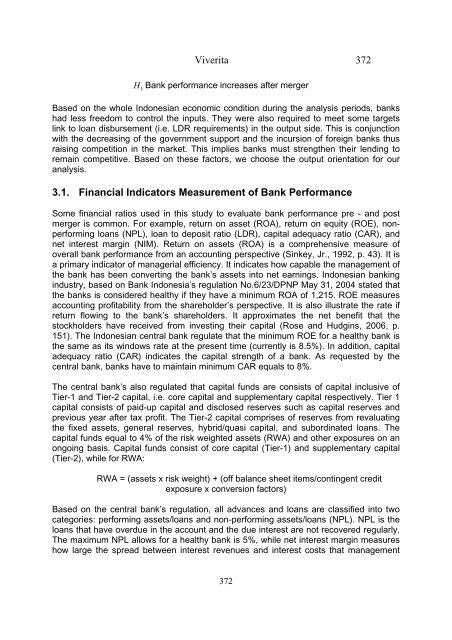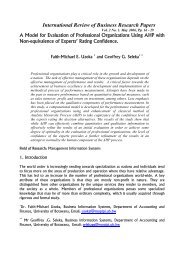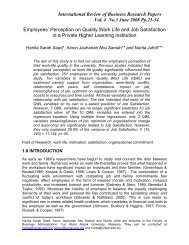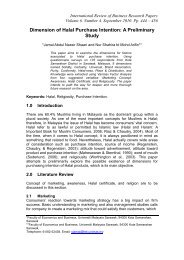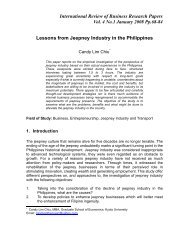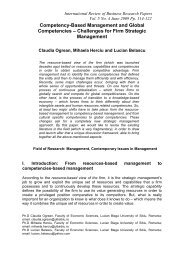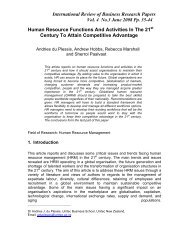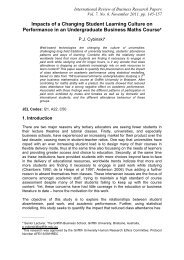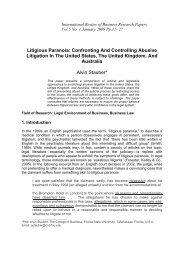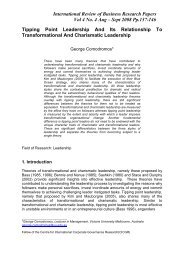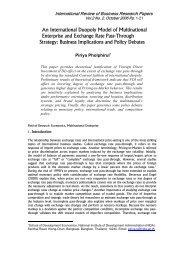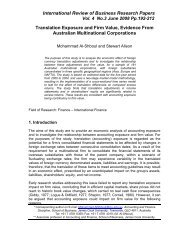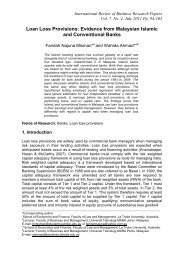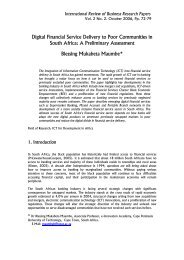International Review of Business Research Papers Vol 4 No. 4 Aug ...
International Review of Business Research Papers Vol 4 No. 4 Aug ...
International Review of Business Research Papers Vol 4 No. 4 Aug ...
Create successful ePaper yourself
Turn your PDF publications into a flip-book with our unique Google optimized e-Paper software.
Viverita 372H1:Bank performance increases after mergerBased on the whole Indonesian economic condition during the analysis periods, bankshad less freedom to control the inputs. They were also required to meet some targetslink to loan disbursement (i.e. LDR requirements) in the output side. This is conjunctionwith the decreasing <strong>of</strong> the government support and the incursion <strong>of</strong> foreign banks thusraising competition in the market. This implies banks must strengthen their lending toremain competitive. Based on these factors, we choose the output orientation for ouranalysis.3.1. Financial Indicators Measurement <strong>of</strong> Bank PerformanceSome financial ratios used in this study to evaluate bank performance pre - and postmerger is common. For example, return on asset (ROA), return on equity (ROE), nonperformingloans (NPL), loan to deposit ratio (LDR), capital adequacy ratio (CAR), andnet interest margin (NIM). Return on assets (ROA) is a comprehensive measure <strong>of</strong>overall bank performance from an accounting perspective (Sinkey, Jr., 1992, p. 43). It isa primary indicator <strong>of</strong> managerial efficiency. It indicates how capable the management <strong>of</strong>the bank has been converting the bank’s assets into net earnings. Indonesian bankingindustry, based on Bank Indonesia’s regulation <strong>No</strong>.6/23/DPNP May 31, 2004 stated thatthe banks is considered healthy if they have a minimum ROA <strong>of</strong> 1,215. ROE measuresaccounting pr<strong>of</strong>itability from the shareholder’s perspective. It is also illustrate the rate ifreturn flowing to the bank’s shareholders. It approximates the net benefit that thestockholders have received from investing their capital (Rose and Hudgins, 2006, p.151). The Indonesian central bank regulate that the minimum ROE for a healthy bank isthe same as its windows rate at the present time (currently is 8.5%). In addition, capitaladequacy ratio (CAR) indicates the capital strength <strong>of</strong> a bank. As requested by thecentral bank, banks have to maintain minimum CAR equals to 8%.The central bank’s also regulated that capital funds are consists <strong>of</strong> capital inclusive <strong>of</strong>Tier-1 and Tier-2 capital, i.e. core capital and supplementary capital respectively. Tier 1capital consists <strong>of</strong> paid-up capital and disclosed reserves such as capital reserves andprevious year after tax pr<strong>of</strong>it. The Tier-2 capital comprises <strong>of</strong> reserves from revaluatingthe fixed assets, general reserves, hybrid/quasi capital, and subordinated loans. Thecapital funds equal to 4% <strong>of</strong> the risk weighted assets (RWA) and other exposures on anongoing basis. Capital funds consist <strong>of</strong> core capital (Tier-1) and supplementary capital(Tier-2), while for RWA:RWA = (assets x risk weight) + (<strong>of</strong>f balance sheet items/contingent creditexposure x conversion factors)Based on the central bank’s regulation, all advances and loans are classified into twocategories: performing assets/loans and non-performing assets/loans (NPL). NPL is theloans that have overdue in the account and the due interest are not recovered regularly.The maximum NPL allows for a healthy bank is 5%, while net interest margin measureshow large the spread between interest revenues and interest costs that management372


